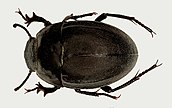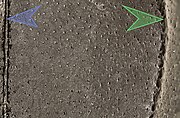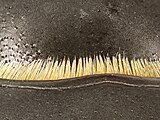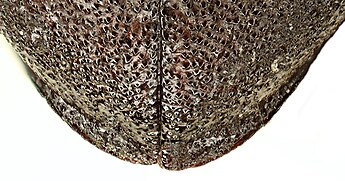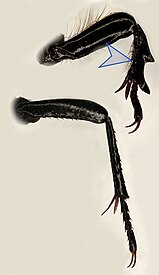Erodius siculus
| Erodius siculus | ||||||||||||
|---|---|---|---|---|---|---|---|---|---|---|---|---|

Erodius siculus dalmatinus |
||||||||||||
| Systematics | ||||||||||||
|
||||||||||||
| Scientific name | ||||||||||||
| Erodius siculus | ||||||||||||
| Solier , 1834 |
Erodius siculus is a beetle from the family of black beetles . The genus Erodius is represented in Europe with twelve species . Erodius siculus forms four subspecies. The distribution area of all subspecies is limited to southern Europe.
Comment on the name
The description of the species Erodius siculus was first presented by Solier at the meeting of the Société Entomologique de France (Entomological Society of France) on June 4, 1834 . The beetles on which the description is based came from Sicily , which explains the name siculus (Sicilian).
In the same session, Solier described Erodius neapolitanus and noted that this may be a variant of Erodius siculus . The beetle is now listed as a subspecies Erodius siculus neapolitanus . The material described comes from Naples , which explains the name neapolitanus .
The subspecies dalmatinus was described by Kraatz from Dalmatia in 1865 (without a precise location). This explains the name dalmatinus .
The subspecies melitensis was described by Reitter in 1914 . Here, too, the name refers to the place where it was found (Latin melitensis = Maltese). The animals are found in Malta .
The genus Erodius was established by Fabricius as early as 1775 . The relation of the generic name (ancient Greek for the bird heron , possibly in a negative sense as a deceiver) to the beetle remains unclear.
Properties of the beetle
The matt black beetle is arched (just under a fifth wider than it is tall) and is only a good one and a half times as long as it is wide. The widespread subspecies dalmatinus is around thirteen millimeters long and eight millimeters wide, other subspecies can be smaller.
The head is carried sloping downwards. It is smooth on top, slightly on the sides and strongly wrinkled towards the front (Fig. 1, bottom right and taxo picture). The eyes are small and transversely oval. They are not shaded from above by an extension of the head skeleton. The sensors (Fig. 3) are cord-shaped. On cursory inspection, they appear to be ten-limbed, but an eleventh limb sits on top of the tenth as a very flat truncated cone. One also finds the description that the antennae are ten-membered with a curled tenth member. The deflection of the feelers is covered by a flap-shaped extension of the cheeks. The third segment of the antennae is elongated, the following segments are cylindrical with almost the same length, from the eighth to the tenth segment the antennae thickens somewhat. The upper lip (half tinted yellow in Fig. 2) is almost transversely rectangular and movably connected to the head skeleton. The upper jaws (tinted pink in Fig. 2 and 4 on the right) end in two teeth, one above the other. The upper tooth is larger and does not stick out upwards. When the jaws are closed, the teeth interlock. The chin (tinted yellow in Fig. 4) fills the throat and completely covers the tongue and most of the lower jaw. The tongue is small, bilobed and ciliate in front. The large jaw buttons (tinted green in Fig. 4) are four-part, the lip buttons (tinted blue in Fig. 4) are three-part.
The pronotum is much wider than it is long and tapers forward. The front corners are rounded, the rear corners are pointed. The base is not truncated almost in a straight line, but rather curved concavely in front of each wing cover (double-bayed). The pronotum has a thin border at the front and side, the edge at the base is only laterally and obsolete . The pronotum is scattered and shallowly punctured on the disk , the puncture becomes somewhat denser on the sides. The pronotum shows a striking golden yellow transverse line at the front edge. This is caused by a fringe of golden yellow eyelashes (Fig. 7). The lash line continues on the sides and underside of the front breast (tinted blue in Fig. 5 on the right). The front chest is pulled forward to the side and encloses the head up to the eyes. The base of the pronotum is slightly wider than the base of the elytra .
Viewed from the side, the side edge of the pronotum does not form an angle with the side edge of the elytra, but the two edges border one another in an arc shape (Fig. 1, bottom left).
The label is not visible.
The elytra are rounded, the greatest width is reached on half the body length. The wing covers are fused together at the seam . They are fine and scattered, but distinctly granular, also near the seam (Fig. 6). The granules are fairly dense towards the tip of the elytra (Fig. 8). The wing covers become increasingly slender towards the rear and end in a common bulge-like extension (Fig. 8). The subspecies differ in the degree of longitudinal rib formation. A distinction is made between an inner dorsal rib, which runs near the suture of the wing cover, an outer dorsal rib or side rib and a humeral rib or marginal rib. The latter is always developed, the other two show a partially overlapping variance. As a rule, however, in the nominate form, the inner dorsal rib is at most indicated, the outer only weakly, often only in color as a shiny line. In the case of the dalmatinus , the inner dorsal rib is also at most indicated, is usually completely absent (taxo image, Fig. 1 top left), but the side rib (green arrowhead in Fig. 6) is clearly raised. In neapolitanus , the outer dorsal rib is also very clearly developed, but also a weak inner dorsal rib. In melitensis the inner dorsal rib is no weaker than the outer one.
On the prosternum of the males, near the front edge, there is a roundish spot in the center with long golden-yellow hair, which Kraatz calls the beard (half of it tinted red in Fig. 5). The beard can be rubbed off, but is still recognizable by a small dimple in its place. The underside of the abdomen is dull in the males, shiny in the females and less dotted than in the males (Fig. 9).
The front and middle hips are spherical, the deflection of the front hips (in Fig. 5, tinted green on the right) is not completely surrounded by the front chest, but like the other hips, the hip cavities are open to the rear. On all three pairs of legs, the hips are separated from each other, the transverse rear hips are particularly far apart.
The legs (Fig. 10) are shorter in females than in males. Erodius siculus belongs to the species of the genus with short and wide front rails, which are almost straight on the inside in the males (green arrow in Fig. 10). In the females, the inside of the front rails is curved (blue arrow in Fig. 10). In both sexes, the fore legs are long ciliated on the inner and outer edges, the front splints only on the inner edge. Also in both sexes, two strong teeth (digging legs) are formed on the outside of the front rails, which are stronger in the females than in the males. All rails have two end pins. The rails on the middle pair of legs are straight, the rails on the hind legs are almost straight. The legs are pressed together at the sides. The tarsi of the hind legs are four-limbed, those of the other legs five-limbed. The tarsi are narrow and long, especially on the middle and rear pair of legs. They are covered with spiky bristles on the sides and underside. The last tarsal link is longer than the first two combined. The claws are fine and long.
biology
The species is strictly psammophilic . It occurs mainly on sand dunes on the coast, in Sicily the beetle is also found inland on sand, in northern Italy on sandy clearings of coastal forests. In a protected area near Rome, the beetles were found on sand dunes, in low maquis and on steppe , but they were absent in high maquis, wetlands, oak and pine forests. They have also been reported from sandy vineyards. With regard to the height distribution of the finds (in Latium ), the beetle is assigned to the lowest altitude level (0–100 m).
The thermophilic and xerophilic animals are adapted to dry and hot locations by a cavity under the wing covers (subelytral cavity) and a thick layer of chitin. The beetles are diurnal and move very quickly over the ground in bright sunshine. They can quickly dig themselves into the sand in the event of malfunctions or adverse weather conditions.
With regard to the seasonal occurrence and the distribution over different zones of the dunes, different studies on the tenebrionid fauna have given different results. Collection results on the west coast of southern Italy show that the beetles occurred all year round, but significantly more frequently in March - April and August - December than in winter and during the hottest season. In another dune in southern Italy, however, the greatest frequency was found in spring and summer, the species was not found in autumn. Specimens buried in the sand were mainly found in January. When comparing the formation zone of the dune (with Echinophora spinosae and the rush-couch grass ), the white dune (with still loose sand, Echinophora spinosae and Ammophila arundinacea ) and the transition to the dune with humus content (with Lotus cytisoides and Crucianella maritima ), in In a study area on the west coast of Italy, the species was most frequently found in the dune with humus content, and most rarely in the formation zone of the dune. In a study area on the east coast of Italy, however, the beetle was only found in the formation zone.
The beetles mainly feed on decaying organic matter ( detritus ). However, they are classified as opportunistic omnivorous , for example they successfully attack the caterpillars of the butterfly Brithys crini .
Within the tenebrionids, the species is one of the larger, which produces few offspring with a relatively low population density and thus follows the reproductive strategy of the K-strategists.
distribution
The species is common in parts of the western Mediterranean and trans-Adriatic (east and west), but not in the north of the Adriatic. The nominate form is restricted to Sicily and the island of Favignana , the subspecies melitensis to Malta. The subspecies neapolitanus occurs in southern Italy on the west coast south of Rome , on the west and east coast of Calabria and on the Aeolian Islands . The subspecies dalmatinus has the largest range. It is known from Greece (island of Corfu), the east coast of Italy, Albania and Dalmatia .
Individual evidence
- ↑ Erodius siculus from Fauna Europaea, accessed October 25, 2019
- ↑ a b Solier: Essai d'une division des coléoptères heteromère et d'une monographie de la famille de Collapterides in Annales de la Société Entomologique de France 3rd volume Paris 1834 p. 479 ff Erodius siculus p. 570 , key for the species P. 528 , key for genera p. 508
- ↑ a b G. Kraatz: Revision of the Tenebrionids of the old world .... Berlin 1865 Erodius dalmatinus p. 44
- ↑ a b Edmund Reitter: Determination table for the subfamily Erodini of the Tenebrionidae from Europe and the neighboring countries in German entomological journal, year 1914, Berlin 1914, p. 43-85 Key genera p. 44 Key species p. 73 p. 77 Erodius melitensis
- ^ Johann Christian Fabricius: Systema entomologiae, sistens insectorvm classes, ordines, genera, species, adiectis synonymis, locis, descriptionibvs, observationibvs Flensburg, Leipzig 1775, p. 44 p. 258 Erodius
- ↑ Norman Douglas: Birds and beasts of the Greek Anthology Project Gutenberg p. 46 the heron as deceiver
- ^ E. Allard: Monograph des espèces de coléoptères du genre Erodius in Revue et Magazin de Zoologie Paris 3rd series 1873 p. 197 Erodius siculus
- ↑ Simone Fattorini: The Tenebrionidae (Coleoptera) of a Tyrrhenian coastal area: diversity and zoogeographical composition in Biogeographia - The Journal of Integrative Biogeography Volume 23 (1), 2002 ISSN 1594-7629 DOI 10.21426 / B6110109 PDF
- ^ A b Josef Müller: Tenebrionidae Dalmatinae in negotiations of the Zoological-Botanical Society in Vienna 70th volume, 3rd - 5th issue, Vienna 1921 p. 132 ff p. 170
- ↑ Simone Fattorini: Variation in zoogeographical composition along a elevational gradient: the tenebrionid beetles of Latium (Central Italy) in Entomologia 2013 vol 1: e6
- ↑ Giuseppe M. Carpaneto, Simone Fattorini: Spatial and seasonal organization of a darkling beetle (Coleoptera, Tenebrionidae) community inhabiting a Mediterranean coastal dune system in Italian Journal of Zoology vol 68, 2001 pp. 201-214 PDF
- ↑ L. Chelazzi, E. Dematthaeis, I. Colombini, M. Fallaci, V. Bandini, C. Tozzi: Abundance, zonation and ecological indices of a coleopteran community from a sandy beach-dune ecosystem of the southern Adriatic coast, Italy in Vie et Milieu vol 55 (2) pp. 127 - 141 (PDF)
- ↑ Simone Fattorini, Davide Bergamaschi, Christina Mantoni, Alicia TR Acosti, Andrea Di Giulio: Niche partioning in tenebrionid species (Coleoptera, Tenebrionidae) inhabiting Mediterranean coastal dunes in European Journal of Entomology vol 113, 2016 pp. 462–468 doi: 10.14411 / eje.2016.060 PDF
- ↑ Giuseppe M. Carpaneto, Simone Fattorini: Flightlessness in psammophilous beetles inhabiting a Mediterranean costal area: ecological and biogeographical implications in Biogeographia vol 23, 2002 PDF
- ↑ Simone Fattorini, Giuseppe M. Carpaneto: Tenebrionid density in mediotyrrhenian coastal dunes: habitat and seasonal variations in Fragmenta entomologica Roma vol 33 (1), pp. 97-118 , 2001 PDF
- ↑ Roland Grimm: On the knowledge of the tenebrionids from southern Italy (Insecta: Coleoptera) in Stuttgart Contributions to Natural History Series A Biology No. 379 Stuttgart 1985 p. 3
